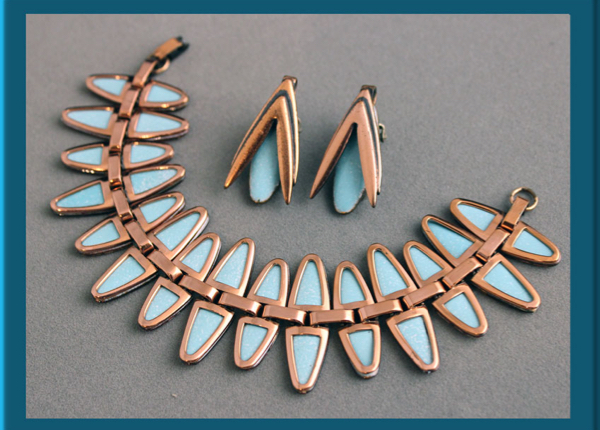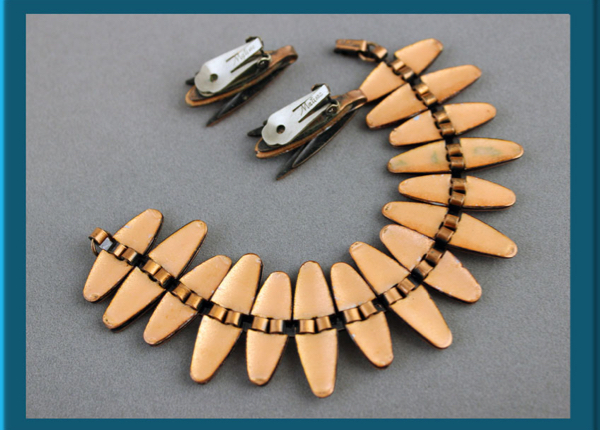Return To Previous Page
Matisse | 'Nefertitti' Bracelet and Earrings Enameled Demi
View
video
Matisse | 'Nefertitti' Bracelet and Earrings Enameled Demi
. . . . Egyptian Grace!
Matisse
Egyptian Lady of Grace. There is no mistaking Matisse or Renoir vintage jewelry. This alluring Matisse Bracelet and Earring Demi are Copper & Blue (aqua) Enamel in the 'Nefertitti' design by Jerry Fels of California and bears the Matisse signature. This exact set is featured in the book, "Signed Beauties of Costume Jewelry Volume II, by Marcia "Sparkles Brown, page 137.
"Matisse" was introduced by Jerry Fels of Renoir in 1952, with the lovely enamel on copper look. After 1954 pieces bore the copyright mark. In the mid-50s Renoir also did sterling silver jewelry and that line was named "Sauteur". Renoir and Matisse Companies were closed in 1964. This Matisse bracelet is an ever popular design, inspired by the jewelry of Queen Nefertitti of Egypt. For the sake of full disclosure I will point out the very small pin dot size missing enamel on the one earring. Really a beautiful set. ID-730
Measurements:
Length: Approximately 7" and Width: Approximately 1 ¼"
Matisse Jewelry History —
Like its namesake, Renoir of California jewelry was about art. But the designs sprang from a humble material-copper-and a partnership forged as tight as solder. Here's how two friends created an amazing legacy.
The story of Renoir of California goes back ... oh, 10,000 years. That's when indigenous Americans were working with natural copper deposits to craft their tools. The human urge to create copper implements both useful and decorative has not abated.
"Copper is a wonderful, warm, forgiving material," says metalsmith Peter Fels. "You can work copper hot or cold, you can cast it, you can stretch it until it's paper thin. Only gold exceeds it in plasticity."
Unlike iron or steel, copper corrodes slowly, another reason it appeals. Fels should know: In addition to being an accomplished sculptor himself, he is also the son of acclaimed designer Jerry Fels. With his friend and brother-in-law, Curtis "Kurt" Freiler, Jerry ran a company that from 1946 to 1964 produced copper designs that are today beloved by jewelry collectors.
American Modernist Jewelers—"I'm not sure that midcentury artists saw themselves as heirs of the Arts and Crafts movement, but they were," says Barry Harwood, PhD., the curator of decorative arts at the Brooklyn Museum in New York. "Particularly in their use of lesser materials such as copper and brass, rather then diamonds, gold or rubies."
The Arts and Crafts movement came out of the work of John Ruskin, the preeminent art critic of England in the Victorian period, and William Morris, a British designer and artist. This movement valued handmade things and humble materials, and believed that good design should be available to a large audience. American midcentury designers were influenced by those earlier ideals, says Harwood, but also incorporated abstraction, biomorphism (shapes that resemble organic forms) and surrealism.
Additionally, "young jewelry designers of the 1930's 'all owe a debt to Alexander Calder and the jewelry he exhibited along with his sculptures," says Harwood. "He was highly influential."
Escaping The Past—In 1938, a young man, skilled in tool and die making and production, fled the Nazis and moved to Boston. Curtis (Kurt) Freiler had been the manager in a factory in Germany, says his son, Robbie, and his goal was to have his own factory. "He was very good at working with people," says Robbie. Freiler moved to California, where he encountered Jerry Fels.
A veteran of World War II, Fels had grown up in New York and worked his way through art school. Before the war interfered, he'd been the unusually young creative director for Gertz department store. "He learned to draw during the Depression," says Peter Fels. "His family was extremely poor; he drew on paper bags." As a result, his drawings were always very cramped and small, a tendency Fels had to fight against as a mature artist.
The production genius and the gifted artist quickly became friends, then family when they married a set of sisters. "At one point, Kurt and my father had bought copper pots and had intended to sell and repair antique copper at the Farmers' Market," says Peter. "Father was fooling around and doing some jewelry, and it sold well." Soon, they had a business, Renoir of Hollywood, on Santa Monica Boulevard, along with a third partner, Nat Zausner, whom Peter describes as "a dyspeptic Communist." By 1948 Zausner was out and the company had been renamed Renoir of California.
The Post-War Years—"The new American woman didn't want her mother's Wedgwood or china. She rejected her mother's gold jewelry," says Dr. Harwood. Bold, copper designs like those by Renoir appealed to these progressive, arts-minded customers.
Modernist jewelers would even "rough up" their pieces further by applying a dark patina. "When you solder copper, of course it has a black area around it, but they artificially added it for greater visual interest," says Harwood. "If you buy this jewelry, and it looks like there's a black shadow on it, don't polish it off!"
Renoir also featured a shiny lacquer finish on its pieces. "I wish my father remembered what it was," says Peter Fels. "He said he had a friend in the Air Force, I think, who was a chemist, and he said they'd had a problem with corrosion and he mixed up a batch of the finish and that's what they used. Even the modern equivalent is not as good."
The company was ahead of its time in other ways, too. An elaborate ventilation system prevented air pollution in the work area. Fels and Freiler also employed minorities and disabled workers, which was unheard of in the 1940s and '50s.
In 1952, the company expanded into enameled copper with a line called Matisse Ltd., and hired a well-regarded African American enamel artist, Curtis Tann.
"I love the enamel work," says Robbie Freiler, who has about 200 pieces in his personal collection. "It's just gorgeous. I remember the women in the factory would sift [the powdered glass] with very fine sifters and then it would all roll into the big kiln. Each was hand done."
The jewelry looked handmade but combined artisanship with machine workmanship, according to Matthew Burkholz, the world's leading authority on copper jewelry and one of the authors of Copper Art Jewelry: A Different Lustre. "The designs were stamped and shear cut, punched. There was hand finishing, hand brushing, hand polishing."
Remember, this was in the time before computers: Machinists had to make everything before production could even start. And this was done for 15 to 20 designs per line, twice a year.
A Sudden End—The company was doing well, with hundreds of employees and salesmen across the country. The company's headquarters at 1755 Glendale expanded into 1759 Glendale, and later another property.
"Things were just roaring along," says Peter Fels. "Then Jackie Kennedy came in. There were clean necklines. No earrings. No necklaces."
There was another threat, too. "Every time they'd come out with a line, a number of imitators would rip them off and do the same design with lousy materials. Defending themselves legally was very expensive," he says. The final straw was an expensive enamel design that was both excruciating to make and very popular. "They had to fire it on constantly rotating rods; it was very difficult and the reject level was high." The company lost money, and then went bankrupt. "Kurt and my dad were left with their tools and the buildings," says Peter.
Undeterred, the two men founded Artisan House, making high-end metal sculptures for the home. The company is still in business today.
Rick Benveniste worked at Artisan House alongside Fels and Freiler for decades. He started there in 1973 and eventually became general manager and vice president. "They were both really a pleasure to work for. I learned so muchabout management from them. You don't get it done with fear and intimidation. They didn't have to scream or holler."
Collecting Renoir and Matisse—The Renoir founders lived long enough to see their jewelry designs become vintage collectibles-Freiler passed away in 2013 at 103, and Fels died at age 90 in 2007.
"Father thought the prices their work was getting on the collector's market were hilarious," says Peter Fels. "The stuff that they worked on that had been $2 and people were now getting $35, $40 for it. Of course, it was also a validation."
Matthew Burkholz has been selling Renoir and Matisse since the mid 1980s. He currently has about 300 pieces at his store, Route 66 West, in Palm Springs, California. The most sought-after pieces are the "boomerang, Sputnik 1950s" styles featuring simple, geometric designs. The sweeter florals tend to be less expensive.
Prices have remained reasonable, Burkholz says. "A truly rare hinge bracelet is maybe $400, $500. Earrings are $15, but they can also go up to $135, $150. There's a range of work that the company put out, just as a Trifari piece can be worth $5 or $5,000."
Due to the craftsmanship, that mysterious lacquer, and the resiliency of copper, gleaming examples of Renoir and Matisse jewelry can still be found today. It's a pleasure to own and wear a piece of this portable, affordable and authentic modern art.
CJCI: by Kathryn Drury Wagner, The Girl, The Gold Watch & Everything: Renoir of California: Midcentury Copper Masters : [https://costumejewelrycollectors.com/2014/10/16/midcentury-copper-masters/]: [Oct 16, 2014]
Having trouble with the small sizes of
yesteryear? Well, most of us do!
The ladies were smaller than the women of today.
NO Problem, be sure to check out our necklace extenders.
The ladies were smaller than the women of today.
NO Problem, be sure to check out our necklace extenders.


